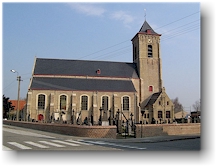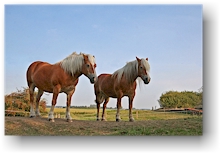|
» Lapscheure church » Ruins first church » Fortress Saint-Donaas » Blue Sluice » Hollandline (bunkers) » Old roadsign "De Vrede" » Reserve "Platte Kreek" » Reserve Fort St.-Donaas » Canal "Damse Vaart" » Farming museum » Kobus' Ferry |
Lapscheure
For those who like to take the bike: take the Zeedijk if you have the time. If you don't have a terrainbike, you'd better take the Groenendijk towards the Zeedijk (because its not paved everywhere). Who does have one, should have no problem to do the whole Zeedijk; at the end of this road you can see the ruins of the old church of Lapscheure. Alongside the dike, you not only have a beautiful sight on the polders with sheep and birds, you will also see several warbunkers in all sizes. Taking this road in the direction of the Damse Vaart, will lead you to the "Blauwe Sluis" (Blue Sluice). Where the road crosses a small stream, you ride over this sluice. Don't hesitate to step off your bike to have a closer look. Further down the road, you reach the canal where you can take Kobus' ferry (end of Moordenaarsstraat). Don't wait for the ferryman; it's self-service. Once crossed the canal, you can see the remains of the fortress of Sint-Donaas. If you continue to the south, you will soon end up in the peacefull village of Hoeke
Fixed events.
History.
In 1652, the present church was built with reusable materials of the destroyed church. She is the only church in the diocese, dedicated to the Holy Trinity and has as patron Saint Christian (as the former church). During the 80-year war (1568-1648) Lapscheure found itself litterally on the frontline between the Northern and Southern Netherlands. This explains the number of fortresses that were constructed in the direct surroundings. The most known one was the fortress of Saint Donaas; others were fortress Frederik and Saint Job During the Spanish succession war, the village again fell prey to the fighting. In 1704, Lapscheure was conquered by the Dutch and added to the Dutch territory in 1715. In the meantime, this situation has been "rectified", as a matter of speaking. On the territory of Lapscheure, not far from the canal (Damse Vaart), there still is on old brick-yard. A piece of industrial heritage that provided work for many people in the region during the last century. Man may take from nature, but in the end, nature prevails. The spades of claydiggers no longer rule in the claypitts, now wildlife has taken over that position. With thanks to Guido Vermeersch for text review. |
|
 General.
General.
 Name.
Name.